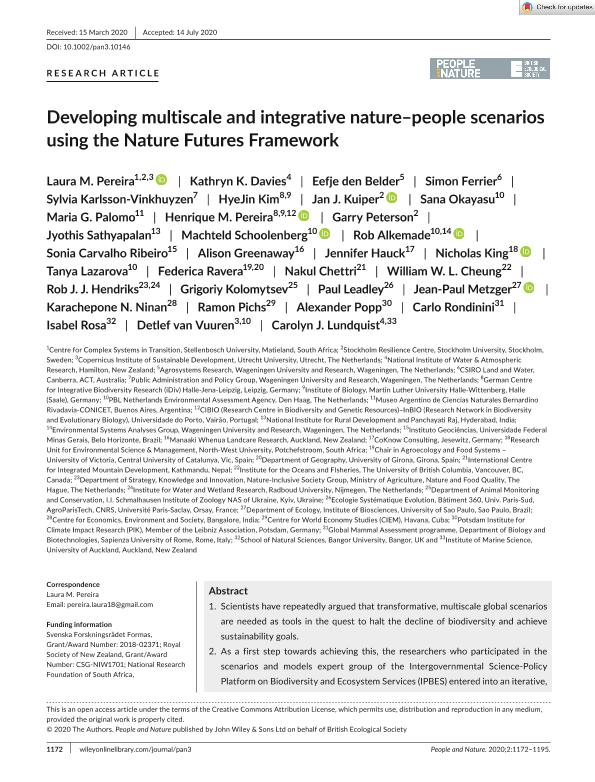Artículo
Developing multiscale and integrative nature–people scenarios using the Nature Futures Framework
Pereira, Laura M.; Davies, Kathryn K.; den Belder, Eefje; Ferrier, Simon; Karlsson Vinkhuyzen, Sylvia; Kim, HyeJin; Kuiper, Jan J.; Okayasu, Sana; Palomo, Maria Gabriela ; Pereira, Henrique M.; Peterson, Garry; Sathyapalan, Jyothis; Schoolenberg, Machteld; Alkemade, Rob; Carvalho Ribeiro, Sonia; Greenaway, Alison; Hauck, Jennifer; King, Nicholas; Lazarova, Tanya; Ravera, Federica; Chettri, Nakul; Cheung, William W. L.; Hendriks, Rob J. J.; Kolomytsev, Grigoriy; Leadley, Paul; Metzger, Jean Paul; Ninan, Karachepone N.; Pichs, Ramon; Popp, Alexander; Rondinini, Carlo; Rosa, Isabel; van Vuuren, Detlef; Lundquist, Carolyn J.
; Pereira, Henrique M.; Peterson, Garry; Sathyapalan, Jyothis; Schoolenberg, Machteld; Alkemade, Rob; Carvalho Ribeiro, Sonia; Greenaway, Alison; Hauck, Jennifer; King, Nicholas; Lazarova, Tanya; Ravera, Federica; Chettri, Nakul; Cheung, William W. L.; Hendriks, Rob J. J.; Kolomytsev, Grigoriy; Leadley, Paul; Metzger, Jean Paul; Ninan, Karachepone N.; Pichs, Ramon; Popp, Alexander; Rondinini, Carlo; Rosa, Isabel; van Vuuren, Detlef; Lundquist, Carolyn J.
 ; Pereira, Henrique M.; Peterson, Garry; Sathyapalan, Jyothis; Schoolenberg, Machteld; Alkemade, Rob; Carvalho Ribeiro, Sonia; Greenaway, Alison; Hauck, Jennifer; King, Nicholas; Lazarova, Tanya; Ravera, Federica; Chettri, Nakul; Cheung, William W. L.; Hendriks, Rob J. J.; Kolomytsev, Grigoriy; Leadley, Paul; Metzger, Jean Paul; Ninan, Karachepone N.; Pichs, Ramon; Popp, Alexander; Rondinini, Carlo; Rosa, Isabel; van Vuuren, Detlef; Lundquist, Carolyn J.
; Pereira, Henrique M.; Peterson, Garry; Sathyapalan, Jyothis; Schoolenberg, Machteld; Alkemade, Rob; Carvalho Ribeiro, Sonia; Greenaway, Alison; Hauck, Jennifer; King, Nicholas; Lazarova, Tanya; Ravera, Federica; Chettri, Nakul; Cheung, William W. L.; Hendriks, Rob J. J.; Kolomytsev, Grigoriy; Leadley, Paul; Metzger, Jean Paul; Ninan, Karachepone N.; Pichs, Ramon; Popp, Alexander; Rondinini, Carlo; Rosa, Isabel; van Vuuren, Detlef; Lundquist, Carolyn J.
Fecha de publicación:
12/2020
Editorial:
John Wiley & Sons
Revista:
People and Nature
ISSN:
2575-8314
Idioma:
Inglés
Tipo de recurso:
Artículo publicado
Clasificación temática:
Resumen
Scientists have repeatedly argued that transformative, multiscale global scenarios are needed as tools in the quest to halt the decline of biodiversity and achieve sustainability goals. As a first step towards achieving this, the researchers who participated in the scenarios and models expert group of the Intergovernmental Science-Policy Platform on Biodiversity and Ecosystem Services (IPBES) entered into an iterative, participatory process that led to the development of the Nature Futures Framework (NFF). The NFF is a heuristic tool that captures diverse, positive relationships of humans with nature in the form of a triangle. It can be used both as a boundary object for continuously opening up more plural perspectives in the creation of desirable nature scenarios and as an actionable framework for developing consistent nature scenarios across multiple scales. Here we describe the methods employed to develop the NFF and how it fits into a longer term process to create transformative, multiscale scenarios for nature. We argue that the contribution of the NFF is twofold: (a) its ability to hold a plurality of perspectives on what is desirable, which enables the development of joint goals and visions and recognizes the possible convergence and synergies of measures to achieve these visions and (b), its multiscale functionality for elaborating scenarios and models that can inform decision-making at relevant levels, making it applicable across specific places and perspectives on nature. If humanity is to achieve its goal of a more sustainable and prosperous future rooted in a flourishing nature, it is critical to open up a space for more plural perspectives of human–nature relationships. As the global community sets out to develop new goals for biodiversity, the NFF can be used as a navigation tool helping to make diverse, desirable futures possible. A free Plain Language Summary can be found within the Supporting Information of this article.
Palabras clave:
BIODIVERSITY
,
FUTURES
,
IPBES
,
MODELS
,
NATURE
,
SCENARIOS
,
VALUES
Archivos asociados
Licencia
Identificadores
Colecciones
Articulos(MACNBR)
Articulos de MUSEO ARG.DE CS.NAT "BERNARDINO RIVADAVIA"
Articulos de MUSEO ARG.DE CS.NAT "BERNARDINO RIVADAVIA"
Citación
Pereira, Laura M.; Davies, Kathryn K.; den Belder, Eefje; Ferrier, Simon; Karlsson Vinkhuyzen, Sylvia; et al.; Developing multiscale and integrative nature–people scenarios using the Nature Futures Framework; John Wiley & Sons; People and Nature; 2; 4; 12-2020; 1172-1195
Compartir
Altmétricas



